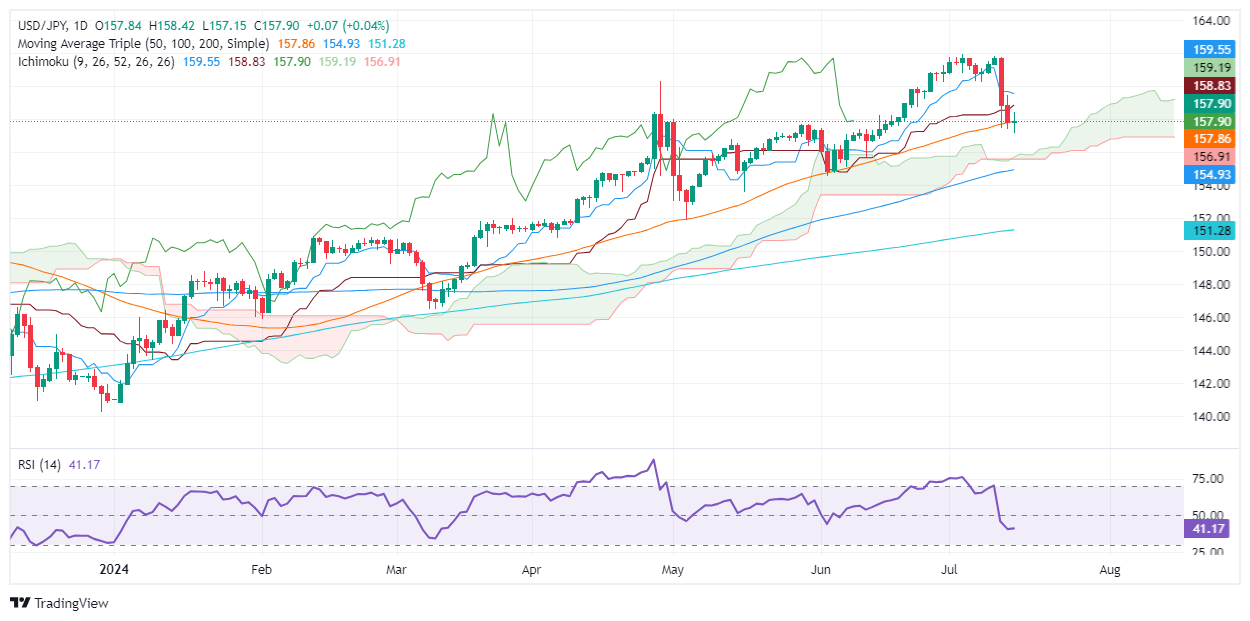USD/JPY Price Analysis: Struggles below 158.00 after intervention, eyes further decline
- USD/JPY minimal losses of 0.02% but holds below key 158.00 level.
- Momentum shifts to sellers, with RSI indicating a neutral to bearish bias.
- Key support levels at 157.14 and 156.91 could lead to further declines below 155.60.
The USD/JPY trades had minimal losses of 0.02%, yet they recovered some ground late in the North American session. The major exchanges hands at 157.94, below the 158.00 figure, following last week’s intervention that dragged the pair from around 161.90 toward 157.50.
USD/JPY Price Analysis: Technical outlook
Although the USD/JPY price action remains above the Ichimoku Cloud (Kumo), indicating that the uptrend remains intact, the pair trades below the Tenkan and Kijun-Sen, breaching the Senkou Span A previous support turning resistance.
Momentum has shifted in the seller's favor, as depicted by the Relative Strength Index (RSI), hinting that the pair is neutral to bearishly biased.
Given the backdrop, the USD/JPY path of least resistance is downwards. Therefore, the USD/JPY's first support would be the July 15 low of 157.14. Once surpassed, the next support would be the Senkou Span B at 156.91, before cracking the Kumo, pushing the exchange rate below 155.60.
Conversely, if USD/JPY climbs past the 158.00 mark and extends its rally above the July 12 high of 159.45, that would pave the way for a challenge of 160.00.
USD/JPY Price Action – Daily Chart
Japanese Yen FAQs
The Japanese Yen (JPY) is one of the world’s most traded currencies. Its value is broadly determined by the performance of the Japanese economy, but more specifically by the Bank of Japan’s policy, the differential between Japanese and US bond yields, or risk sentiment among traders, among other factors.
One of the Bank of Japan’s mandates is currency control, so its moves are key for the Yen. The BoJ has directly intervened in currency markets sometimes, generally to lower the value of the Yen, although it refrains from doing it often due to political concerns of its main trading partners. The current BoJ ultra-loose monetary policy, based on massive stimulus to the economy, has caused the Yen to depreciate against its main currency peers. This process has exacerbated more recently due to an increasing policy divergence between the Bank of Japan and other main central banks, which have opted to increase interest rates sharply to fight decades-high levels of inflation.
The BoJ’s stance of sticking to ultra-loose monetary policy has led to a widening policy divergence with other central banks, particularly with the US Federal Reserve. This supports a widening of the differential between the 10-year US and Japanese bonds, which favors the US Dollar against the Japanese Yen.
The Japanese Yen is often seen as a safe-haven investment. This means that in times of market stress, investors are more likely to put their money in the Japanese currency due to its supposed reliability and stability. Turbulent times are likely to strengthen the Yen’s value against other currencies seen as more risky to invest in.

